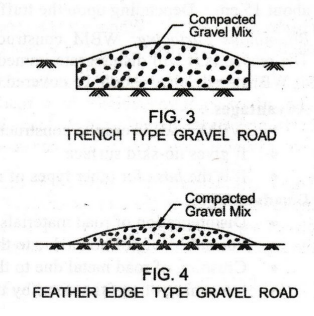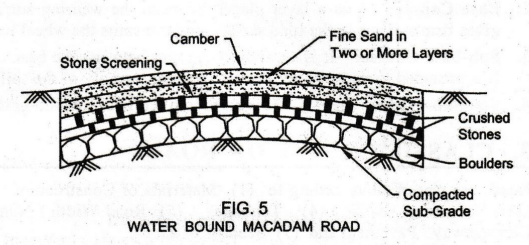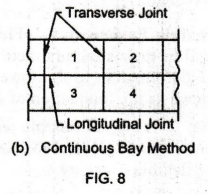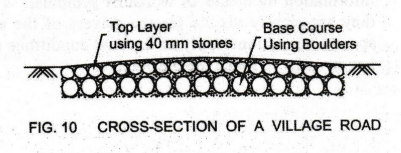Basic Civil & Mechanical Engineering: UNIT I: g. Transportation engineering
Classification of roads
Roads are classified according to (1) Materials of Construction, (2) Location and Function, (3) Volume of Traffic, (4) Tonnage, (5) Road Width / Number of Lanes, (6) Type of Carriageway / Pavement and (7) Seasons of a Year.
CLASSIFICATION OF ROADS
Roads
are classified according to (1) Materials of Construction, (2) Location and
Function, (3) Volume of Traffic, (4) Tonnage, (5) Road Width / Number of Lanes,
(6) Type of Carriageway / Pavement and (7) Seasons of a Year.
1. CLASSIFICATION ACCORDING TO THE MATERIALS OF CONSTRUCTION
i.
Earth Road
Earth
Road is the cheapest type of road constructed from natural soil available at
the location. In order to drain the rain water, steep camber is provided.
ii.
Gravel Roads
Gravel
Road are also cheap type of roads. It is actually intermediate between earthen
and metal roads using crushed (broken) stones.
The
carriageway is made by compacting a mixture of gravel and earth. The mixture
consists of 26% sand, 13% clay and 61% gravel. The sand-clay mixture not only
binds the gravel together, but also fills the voids between the gravel mixture.
The
mixture is spread on the rolled sub-grade to get a final thickness of 15 cm to
30 cm, according to the requirement of traffic.
The
construction is done by adopting either Trench Type Method or Feather Edge Type
Method as shown in Fig. 3 and Fig. 4.

iii.
Water Bound Macadam (WBM) road
It
is named after a Scot civil engineer John Macadam. It is superior to Earth and
Gravel Roads but inferior to Bituminous and Concrete Roads.
It
is suitable for animal-drawn vehicles with steel-tyred wheels. It wears fast
under vehicles with pneumatic tyres because of their high speed and heavy load.
Village roads and roads in newly developing townships are laid as WBM roads.
The
term Water Bound Macadam is applied to a layer of Crushed Stone aggregate.
Crushed Stone is also known as Road Metal.
As
the name suggests, the WBM roads are such roads in which crushed stone
aggregate is kept bonded by the action of rolling and voids filled with binding
materials (fine sand) by sprinkling water. It is used as the Base Course of the
road. Binding action is obtained by using stone dust as filler in the presence of
water.
Construction:
See Fig. 5. Soil Sub-grade is prepared with a Camber of 1 in 30 or 1 in 40.

Then,
Boulders are laid firmly. The voids are filled with small stones and rolled
with a roller. Over this base, Crushed Stones are spread in one or two layers
and compacted.
After
rolling, Stone Screening is applied to fill the voids in the course aggregates.
The surface is sprinkled with water. Then, Fine Sand (binding material) is
filled in two or more layers.
WBM
construction is made in layers, each layer not exceeding compacted thickness of
about 15 cm. Depending upon the traffic, the total thickness may vary from 10
to 30 cm.
Bituminous
Surfacing: WBM construction should not be put to use as the surfacing layer.
The reason is it will disintegrate immediately under traffic. Therefore, to
prevent disintegration of WBM roads, they should be covered by Bituminous
Surfacing.
Advantages
•
WBM roads is easy to construct and cheap in initial cost.
•
It gives no-skid surface.
•
It is the base for other types of road. Later construction of other roads is
easy.
Disadvantages
•
Disintegration of road materials due to heavy traffic.
•
Formation of pot-holes due to the loss of soil binder by rain water washing.
•
Crushing of road metal due to the impact by steel tyred wheels.
•
Loosening of surface metal by the suction of binder caused by pneumatic wheel
tyres.
iv.
Bituminous Road (Flexible Pavement)
Bituminous
Road is a flexible pavement formed of broken stone aggregate and bituminous
binder. There are many types of bituminous roads. The selection of the type of
bituminous surfacing, thickness of road surface and the method of laying the
bituminous surface depend on the volume. of the traffic and the intensity of
the load transmitted by the traffic.
Advantages
•
The abrasion of stones is reduced due to the slurry layer being firmly bonded
by bitumen.
•
Bituminous road is free from cracks. Therefore, it offers a smooth riding.
•
It is resistant to weathering agencies like wind, heat and rain. It resists
action due to soil moisture. Hence, it is dust-free and non-slippery.
•
It is fairly impervious.
•
There is no glare due to light reflection. Hence, accidents are minimized.
Disadvantages
•
It requires strong foundation.
•
It develops corrugations or pot-holes.
•
Under extreme heat, it is liable to become soft and will creep under traffic.
•
It is not suitable for heavy iron-tyred traffic which cuts the surface.
Methods
of Construction of Bituminous Road
The
method of construction of bituminous road varies with the type of surfacing
adopted. We shall discuss the following three important methods:
(i)
Single and Multiple Surface Treatment Method
•
Preparation of the Base: The base for surface treatment (surface dressing) is
the already laid earth, gravel or Water Bound Macadam Road. Loose materials on
the existing road surfaces are removed. The surface is brought to the required
level and camber. It is well compacted.
•
Laying of Bitumen-aggregate Course: After the base is prepared, Bituminous
materials like Asphalt and Road tar are applied on the base. Crushed Stone
Aggregates are spread evenly on the bituminous material.
•
Surface Dressing: Then the surface is rolled using 10 tonne roller. This
surface dressing should be done during warm sunny weather. (Surface dressing
done during cold weather will not be durable.)
•
Laying of Multiple Courses: Bituminous material and crushed stone aggregate are
applied more than once. Coarse aggregates are used for the bottom layer. The
size of aggregates is reduced for the successive layers.
(ii)
Semi-grouting Method (Fig. 6)
•
Preparation of the Base: The unevenness in the existing surface is removed. The
surface is brought to the required level and Camber. It is well compacted.
•
Laying Slurry Material: A thin course of gravel or sand is spread on the base.
•
Spreading the Coarse Aggregate: Stone aggregates are spread on the slurry.
Water is sprinkled. The surface is well compacted by rolling. The slurry fills
partly the voids present in the aggregates.

•
Laying Bitumen and Key Stone Course: The bituminous material is applied
uniformly. Key Stones are spread on the bituminous material. The surface is
again compacted by rolling.
•
Application of Sealing Coat: The surface thus formed is sealed by spreading a
layer of aggregates and applying a thin coat of bitumen at the top.
The
bituminous road thus laid is thrown open to traffic after 24 hours of applying
the sealing coat.
(iii)
Penetration Macadam or Bituminous Macadam Road
It
is a high type surface above which more than 1000 vehicles can pass in a day. National
highways are laid by this method.
•
Preparation of the base: The unevenness in the existing surface is removed. The
surface is brought to the required level and camber. It is well compacted.
•
Laying Course Aggregate: Course aggregates are spread on the prepared surface
and rolled well.
•
Application of Bituminous Material and Key Stones (First Stage): Bituminous
material is applied on the course aggregate. Key Stones are spread on the
bituminous material. The surface is rolled.
•
Application of Bituminous Material and Key Stones (Second Stage): Another coat
of bituminous material is applied on the key stone layer. Another course of key
stones is laid on the above. The surface is rolled again. Application of
Bituminous Material (Third Stage): Third coat of bituminous material is applied
on the key stone layer.
•
Sealing the surface: The surface formed as above is sealed by spreading chips.
The surface is finished by rolling.
e.
Cement Concrete Road (Rigid Pavement)
Road
constructed of Cement Concrete with or without steel reinforcement is called
Cement Concrete Road or simply, Concrete Road. It is a rigid pavement. It can
be constructed with or without the sub-base course. The materials required are:
Cement, Stone Aggregate, Sand and Water.
Cement
Concrete Road can be laid directly on a well prepared Sub-grade. Only in the
case of some compressible soils, Granular Sub-base is required.
Construction
•
Preparation of Sub-grade and Sub Base: If the sub-grade is
not too compressible, the concrete road may be constructed directly on the
sub-grade. Otherwise, a Sub-base is provided. A camber of 1: 70 to 1 : 100 is
provided on the Sub-grade / Sub-base. The sub-grade or sub-base is kept in
moist condition when the cement concrete is placed, so that it should not
absorb water from the concrete.
•
Placing of Cement Concrete Steel or wooden forms are used for
formwork. Forms are kept in position. Well-mixed cement concrete is placed
uniformly on the sub-grade. Concreting is done two layers, namely, Bottom
Course Concrete Slab and Top Course Concrete Slab. See Fig. 7.

Bays:
Multi-lane roads are divided into Bays 1, 2, 3, etc. The construction of
concrete pavement may be Alternate Bay Method or Continuous Bay Method. In
Alternate Bay Method, the bays are laid alternatively as per the sequence
numbered in Fig. 8(a).

In
Continuous Bay Method, all the bays are laid continuously on one side as per
the sequence numbered in Fig. 8(b).

This
method is preferred, because the construction can be done on one half and
traffic allowed on the other side.
Joints:
Expansion and Contraction Joints are provided both in the longitudinal
(parallel to the road) and transverse directions.
•
Compaction and Finishing: Concrete is well compacted with
vibrator. The compacted concrete is leveled and finished to the required
cross-section and gradient, using long straight edges and wooden screeds. The
unevenness of the surface is removed by using a wooden float.
•
Curing: The concrete surface is cured by covering it with wet gunny bags
or wet sand.
•
Filling the Joints: Joints are filled with plastic fillers
like mix of asphalt and saw dust.
Advantages
•
Concrete road is smooth, rigid and dustless.
•
It can withstand any volume and intensity of traffic.
•
Wear and tear caused is minimum.
•
It can be laid on any sub-grade.
•
It does not develop corrugations.
•
It can be easily reinforced when required.
•
It has better weather-resisting qualities.
•
It has pleasing appearance with long life and less maintenance.
Disadvantages
•
Cost of construction is very high.
•
Construction of concrete road requires skilled labour and skilled supervision.
•
More number of joints is to be provided, which prove to be weak spots.
•
28 days curing is required after completion, before they can be opened for
traffic.
•
It causes noise under iron-wheeled traffic.
•
It glares due to light reflection and it may lead to accident...
•
Concrete road surface after sometime becomes very smooth and slippery.
•
The cutting and filling of concrete road for works like pipe laying is very
difficult.
f.
Flexible Pavement Vs Rigid Pavement
Similar
to building, a road has two major components, namely, Foundation called
Sub-grade and Superstructure called Pavement. The function of the pavement is
to receive and distribute the wheel loads. There are two types of road
structures or pavements, Flexible Pavement and Rigid Pavement.
Flexible
Pavements: Flexible Pavements have low flexural strength.
Hence, they are less rigid in their structural action under the wheel loads.
The layers of flexible pavement transfer the deformation to the lower layers
and then up to the soil sub-grade. [Soil-sub grade is also known as the
foundation of a pavement.]
A
typical flexible pavement consists of four components. (1) Soil Sub-grade (2)
SubBase Course, (3) Base Course and (4) Surface Course. All pavements except
cement concrete are flexible in nature.
Rigid
Pavements: Concrete roads come under the classification of
rigid pavements, because they offer considerable resistance to deformation.
Concrete pavements are directly supported on sub-grade. They require no
separate wearing course. They consist of three components. (1) Soil Sub-grade
(2) Base Course and (3) Cement Concrete Slab.
They
provide an excellent riding surface. Concrete roads are dust free, less
maintenance cost, having long life, offer less tractive resistance and perform
well under poor sub-grades. However, these involve a higher initial cost and
may become very smooth and slippery after sometime.
2. CLASSIFICATION ACCORDING TO THE LOCATION AND FUNCTION
Specifications
of Indian Road Congress IRC : 73 - 1980 [Geometric Design Standards for Rural
(non-urban) highways) are followed in this Section.
Urban
roads are formed and maintained by municipalities and corporations. But,
nonurban roads are classified based on their location. IRC classifies non-urban
roads as follows:
1.
National Highways (NH): These are the main highways
running across the country both length-wise and breadth-wise. They connect
State Capitals, Industrial and Tourist Centers, Major Ports and Highways of
Neighboring Countries.
National
Highways should have at least two lane traffic. It should have high class
surface finishing together with adequate structural strength. Fig. 9 shows the cross-section
details of national highway.

NH
roads are assigned a number for easy identification as below:
NH44
– Delhi – Ambala – Amritsar - Agra - Varanasi – Kolkata
The
National Highways which are crossing/starting from Tamil Nadu are:
NH16
-Chennai – Vizakapatnam - Cuttack - Jharpokharta;
NH209
– Madurai – Dindugul;
NH544
– Salem - Quilon – Trivandrum - Kanyakumari.
NH48
– Chennai - Bengaluru - Pune - Thane;
NH87
- Madurai – Rameswaram;
2.
State Highway (SH): The roads connecting district
headquarters and important cities within the State are called State Highways.
They connect cities with NH or Highways of neighboring States.
3.
Major District Road (MDR): These are the main roads of
importance that connect important towns with the district headquarters within
the district concerned.
4.
Other District Road (ODR): These are minor district roads
connecting villages with towns.
5.
Village Roads: See Fig. 10.

These
are the roads connecting villages or groups of villages with each other and
also with the nearby towns. These roads can be stabilized earth roads. If metal
surface is provided, it can serve more useful purpose.
3. CLASSIFICATION ACCORDING TO THE VOLUME OF TRAFFIC
1.
Light Traffic Roads: Roads handling up to 400 vehicles per day is Light or Low
Traffic Roads.
2.
Medium Traffic Roads: Roads carrying 400 - 1000 vehicles per day are rated as
Medium Traffic Roads.
3.
Heavy Traffic Roads: Roads carrying traffic more than 1000 vehicles per day are
called Heavy Traffic Roads.
4. CLASSIFICATION ACCORDING TO TONNAGE
Roads
may be classified as class I, II etc. or class A, B etc. and the limits may be
expressed in terms of 'tonnes per day'.
5. CLASSIFICATION ACCORDING TO ROAD WIDTH / NUMBER OF LANES
1.
Single Lane Road 2. Double Lane Road
3.
Three Lane Road 4. Multi-lane Road
6. CLASSIFICATION ACCORDING TO TYPE OF CARRIAGEWAY / PAVEMENT
1.
Paved Roads: These are provided with a hard pavement
course with a water bound macadam base.
2.
Unpaved Roads: These are not provided with hard
pavement course. E.g., Earth Roads and Gravel Roads.
7. CLASSIFICATION ACCORDING TO SEASONS OF A YEAR
1.
All-weather roads: They are negotiable during all seasons
of the year. At major river crossings, some interruption to traffic is
permissible up to a certain extent. The road pavement should be negotiable during
all weather conditions.
2.
Fair-weather roads: The traffic may be interrupted during
monsoon seasons at causeways where streams may overflow across the road.
Basic Civil & Mechanical Engineering: UNIT I: g. Transportation engineering : Tag: : - Classification of roads
Related Topics
Related Subjects
Basic Civil and Mechanical Engineering
BE3255 2nd Semester 2021 Regulation | 2nd Semester EEE Dept 2021 Regulation
